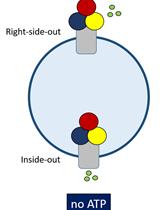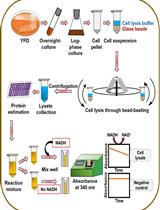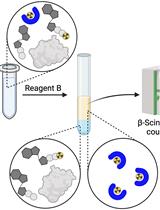- EN - English
- CN - 中文
In vitro Assays for Eukaryotic Leading/Lagging Strand DNA Replication
真核先导链/后随链DNA复制的体外分析
发布: 2017年09月20日第7卷第18期 DOI: 10.21769/BioProtoc.2548 浏览次数: 10141
评审: Gal HaimovichVamseedhar RayaproluDavid Paul
Abstract
The eukaryotic replisome is a multiprotein complex that duplicates DNA. The replisome is sculpted to couple continuous leading strand synthesis with discontinuous lagging strand synthesis, primarily carried out by DNA polymerases ε and δ, respectively, along with helicases, polymerase α-primase, DNA sliding clamps, clamp loaders and many other proteins. We have previously established the mechanisms by which the polymerases ε and δ are targeted to their ‘correct’ strands, as well as quality control mechanisms that evict polymerases when they associate with an ‘incorrect’ strand. Here, we provide a practical guide to differentially assay leading and lagging strand replication in vitro using pure proteins.
Keywords: Eukaryotic DNA replication (真核DNA复制)Background
Using pure proteins from Saccharomyces cerevisiae, our lab was the first to reconstitute a functional eukaryotic DNA replisome, a ~2 MDa complex that includes the 11-subunit CMG helicase (complex of Cdc45, Mcm2-7, GINS heterotetramer), the 4-subunit DNA polymerase (Pol) ε, the 4-subunit Pol α-primase, the PCNA (Proliferating Cell Nuclear Antigen) clamp homotrimer ring shaped processivity factor that encircles duplex DNA, the 5-subunit clamp loader RFC (Replication Factor C) that uses ATP to open and close the PCNA sliding clamp ring onto primed sites for polymerase processivity, and the RPA (Replication Protein A) heterotrimeric single-strand DNA binding protein that removes secondary structure obstacles to DNA polymerase progression. In our initial studies we discovered that Pol ε is targeted to CMG on the leading strand after priming by Pol α-primase, while Pol δ is targeted to PCNA clamps on the lagging strand primed sites (Georgescu et al., 2014; Langston et al., 2014). We next reconstituted a functional coupled leading/lagging strand replisome which included the 4-subunit Pol α-primase and 3-subunit Pol δ, in which we demonstrated that Pol ε is inactive on the lagging strand and Pol ε is inactive on the leading strand (Georgescu et al., 2015). Interestingly, the Pol α-primase, which lacks proofreading activity, was active with CMG on both strands, but when either Pol ε or Pol δ are present, which both contain a proofreading 3’-5’ exonuclease for high fidelity synthesis, they take over from the low fidelity Pol α-primase on either strand. However, Pol ε and Pol δ only performed optimal synthesis when on their respective correct strands (Georgescu et al., 2015). In a subsequent study we characterized the unprecedented quality control mechanisms that exclude these polymerases from incorrect strands, a job that bacterial replisomes do not need to do because they utilize identical polymerases for both strands (Schauer et al., 2017). We found that on the lagging strand, Pol ε is excluded from primed sites by competition with the RFC clamp loader for the primer terminus, while CMG binds and protects Pol ε from RFC inhibition on the leading strand. In contrast Pol δ is preferentially targeted to PCNA on lagging strand primed sites through a tight binding affinity to PCNA clamps that is over 20-fold greater than the PCNA affinity to Pol ε and is unaffected by competition by the RFC clamp loader (Schauer et al., 2017). Interestingly, no stabilizing interaction with CMG exists for Pol δ (Schauer et al., 2017). Furthermore, Pol δ is less stable on a completed DNA than when idling at a primer terminus or extending a primer. Specifically, Pol δ is known to be stable for over a half hour with PCNA, consistent with its high processivity, but upon completing replication of a section of DNA, and bumping into a completed dsDNA region, it dissociates rapidly (i.e., < 1 min) from PCNA-DNA in a process referred to as collision release (Langston and O’Donnell, 2008; Langston et al., 2014).This inherent instability of Pol δ-PCNA upon completing replication may serve as a quality control to destabilize Pol δ-PCNA on the leading strand because Pol δ-PCNA is much faster than CMG unwinding and will be in a constant state of having completed DNA and collision with CMG (Schauer et al., 2017). Destabilization of Pol δ-PCNA when there is no more DNA to be extended should not be taken to mean that Pol δ instantly ejects from PCNA. For example, Pol δ-PCNA remains on DNA for a few seconds to fill-in short gaps upon RNA removal at 5’ ends of Okazaki fragments (Stodola and Burgers, 2016).
In interrogating these various activities, we observed that CMG does not load onto small (100-200 bp) rolling circle replication substrates, which are often used to study replisome behavior in bacterial systems. Thus, we turned to linear DNA fork assays as an alternative to address biochemical mechanisms in eukaryotic replication. These assays enable one to easily separate leading from lagging strand replication activity by synthesis of a long linear DNA that has no dC in one strand, and thus no dG in the other strand. By doing so, one can specifically monitor leading or lagging strand synthesis depending on the radioactive deoxyribonucleoside triphosphate (dNTP) used in the assay.
Materials and Reagents
- Razor blade
- 1.57 mm OD polyethylene tubing (e.g., Clay Adams® Intramedic®, BD, catalog number: 427431 )
- Sephadex microcentrifuge columns (Illustra Microspin G-25) (GE Healthcare, catalog number: 27-5325-01 )
- Plastic wrap (e.g., Fisherbrand Clear Plastic Wrap, Fisher Scientific, catalog number: 22-305654 )
- C-fold paper towels (e.g., Scott paper towels, KCWW, Kimberly-Clark, catalog number: 01510 )
- Positively charged nylon DNA blotting membrane (Hybond-N+, 30.0 x 50.0 cm) (GE Healthcare, catalog number: RPN3050B )
- Chromatography transfer paper (Whatman 3MM, 46.0 x 57.0 cm) (GE Healthcare, catalog number: 3030-917 )
- Syringe tip (e.g., B-D 18 G 1 ½ PrecisionGlide® Needle) (BD, catalog number: 305196 )
- phiX174 virion DNA, 1 mg/ml (New England Biolabs, catalog number: N3023L )
- Phi29 DNA polymerase (New England Biolabs, catalog number: M0269S )
- 100 mM dNTP (deoxynucleotide triphosphate) set (Thermo Fisher Scientific, Thermo ScientificTM, catalog number: R0181 )
- 1 μM CMG (Cdc45 Mcm2-7 Gins) helicase (see Georgescu et al. [2014] for purification details)
- pUC19, 1 mg/ml (New England Biolabs, catalog number: N3041L )
- BsaI-HF with CutSmart buffer (New England Biolabs, catalog number: R3535L )
- ‘blockLd’ oligo*
- ‘blockLg’ oligo*
- ‘Pr1B’ oligo*
- ‘160Ld’ oligo*
- ‘91Lg’ oligo*
- ‘Fork primer’ oligo*
- Nucleotide-biased template (synthesized by Biomatik, Wilmington DE)*
*Note: See Supplementary file 1.
- T4 ligase, including 10x ligase buffer (New England Biolabs, catalog number: M0202M )
- 100 mM ATP (GE Healthcare, catalog number: 27-2056-01 )
- 0.5 M EDTA, disodium salt (Sigma-Aldrich, catalog number: E5134 )
- 5 M NaCl (Sigma-Aldrich, catalog number: S9888 )
- Sepharose 4B size exclusion chromatography resin (GE Healthcare, catalog number: 17012001 )
- 1 kb MW marker (New England Biolabs, catalog number: N3232L )
- Ethidium bromide (EthBr, 10 mg/ml) (Thermo Fisher Scientific, InvitrogenTM, catalog number: 15585011 )
- T4 kinase and 10x T4 kinase buffer (New England Biolabs, catalog number: M0201L )
- 32P-γ-ATP, 3,000 Ci/mmol, 3.3 μM (PerkinElmer, catalog number: BLU002A )
- Type XI low-melt agarose (Sigma-Aldrich, catalog number: A3038 )
Note: This product has been discontinued. - BtsCI (New England Biolabs, catalog number: R0647L )
- β-Agarase I (New England Biolabs, catalog number: M0392L )
- 3 M sodium acetate (CH3COONa), pH 5.2 (Sigma-Aldrich, catalog number: S2889 )
- Isopropanol (Sigma-Aldrich, catalog number: 190764 )
- Glycogen, molecular biology grade (Thermo Fisher Scientific, Thermo ScientificTM, catalog number: R0561 )
- Ethanol (Sigma-Aldrich, catalog number: E7023 )
- 1 μM RFC (Replication Factor C; see Georgescu et al. [2014] for purification details)
- 5 μM PCNA (Proliferating Cellular Nuclear Antigen; see Georgescu et al. [2014] for purification details)
- 2 μM Pol ε (see Georgescu et al. [2014] for purification details)
- 2 μM Pol δ (see Georgescu et al. [2014] for purification details)
- 2 μM Pol α (see Georgescu et al. [2014] for purification details)
- 20 μM RPA (Replication Protein A; see Georgescu et al. [2014] for purification details)
- 32P-α-dCTP, 3,000 Ci/mmol, 3.3 μM (PerkinElmer, catalog number: BLU013H )
- 32P-α-dGTP, 3,000 Ci/mmol, 3.3 μM (PerkinElmer, catalog number: BLU514H )
- LE agarose (BioExpress, GeneMate, catalog number: E-3120-500 )
- 10 N sodium hydroxide (NaOH) (Fisher Scientific, catalog number: SS255 )
- Glycerol
- Xylene cylanol
- Tris-HCl, pH 8.0
- Tris base (RPI, catalog number: T60040-500.0 )
- Boric acid (RPI, catalog number: B32050-5000.0 )
- Sodium citrate
- 1-Butanol
- Tris-acetate, pH 7.5
- Bovine serum albumin (BSA) (New England Biolabs, catalog number: B9000S )
- Tris(2-carboxyethyl)phosphine (TCEP) pH 7.5
- 100 mM dithiothreitol (DTT) (Thermo Fisher Scientific, Thermo ScientificTM, catalog number: R0861 )
- Potassium glutamate
- Magnesium acetate
- 1% SDS
- 6x gel loading dye (see Recipes)
- TE buffer, pH 8.0 (see Recipes)
- 10x TBE (Tris/Borate/EDTA; see Recipes)
- DNA elution buffer (see Recipes)
- 20x SSC (see Recipes)
- 1-Butanol saturated water (see Recipes)
- 5x TDBG (see Recipes)
- 10x MK (see Recipes)
- dA/dC mix (see Recipes)
- dT/dG mix (see Recipes)
- T/G/C mix (see Recipes)
- Stop solution (see Recipes)
- Alkaline running buffer (see Recipes)
Equipment
- Heating block (e.g., VWR, catalog number: 12621-084 )
- Fraction collector (e.g., Gilson, model: F203B )
- Variable mode gel imager (e.g., GE Typhoon)
- UV-vis spectrophotometer (e.g., Thermo Fisher Scientific, Thermo ScientificTM, model: NanoDropTM 2000 )
- Vacuum dessicator (e.g., Thermo Fisher Scientific, Thermo ScientificTM, catalog number: 5309-0250 )
- UV light box
- UV blocking face shield (e.g., Sigma-Aldrich, catalog number: F8142 )
Note: This product has been discontinued. - Microcentrifuge
- Conductivity meter (e.g., Radiometer Medical, model: CDM 80 )
- Temperature controlled water bath with microcentrifuge tray (e.g., LabX, model: Lauda E100 and Brinkman 30x x 1.5 ml)
Manufacturer: LAUDA-Brinkmann, model: E100 . - Phosphorimaging screen (GE Healthcare)
- Phosphor imager (e.g., GE Typhoon)
- A heavy weight
Note: We use giant lead blocks that we found; a ~50 lb dumbell would work. - Computer with ImageJ and spreadsheet software (e.g., Apache Open Office) installed
- 1 x 30 cm glass column (e.g., glass Econo-Columns®) (Bio-Rad Laboratories, catalog number: 7371032 )
- 100 ml agarose gel electrophoresis apparatus
- Styrofoam box large enough to fit 100 ml agarose gel electrophoresis apparatus
- Electrophoresis power supply (e.g., Pharmacia Biotech, catalog number: EPS 3500 XL )
- Analytical balance
- Protective plexiglass samples shield
- 20 x 14 cm horizontal agarose gel electrophoresis apparatus (C.B.S. Scientific, catalog number: SGU-014T-02 )
Software
Procedure
文章信息
版权信息
© 2017 The Authors; exclusive licensee Bio-protocol LLC.
如何引用
Schauer, G., Finkelstein, J. and O’Donnell, M. (2017). In vitro Assays for Eukaryotic Leading/Lagging Strand DNA Replication. Bio-protocol 7(18): e2548. DOI: 10.21769/BioProtoc.2548.
分类
生物化学 > 蛋白质 > 活性
分子生物学 > DNA > DNA 合成
您对这篇实验方法有问题吗?
在此处发布您的问题,我们将邀请本文作者来回答。同时,我们会将您的问题发布到Bio-protocol Exchange,以便寻求社区成员的帮助。
Share
Bluesky
X
Copy link













